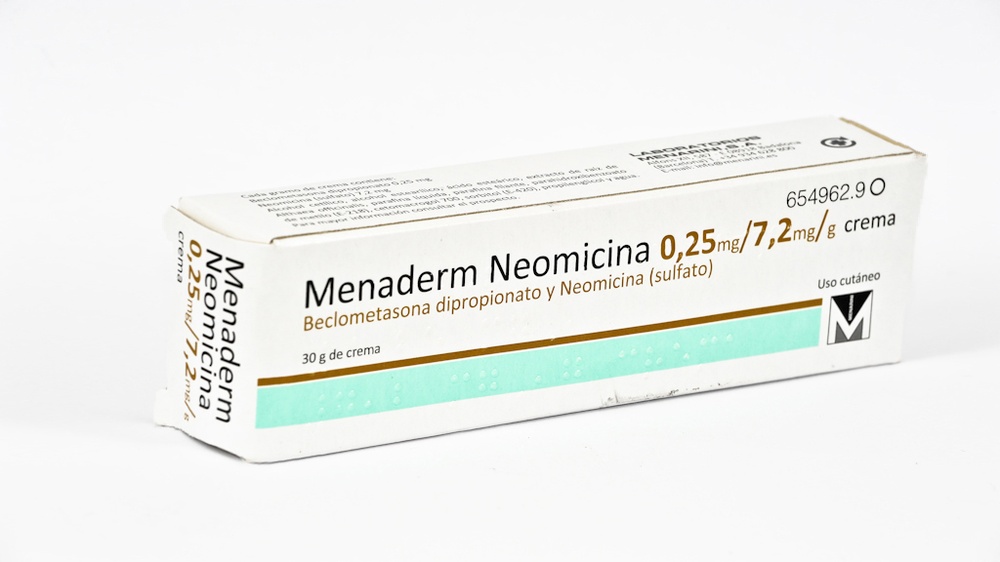

MENADERM NEOMICIN 0.25 mg / 7.2 mg/g CREAM

Ask a doctor about a prescription for MENADERM NEOMICIN 0.25 mg / 7.2 mg/g CREAM

How to use MENADERM NEOMICIN 0.25 mg / 7.2 mg/g CREAM
Introduction
Package Leaflet: Information for the User
Menaderm Neomycin 0.25 mg/ 7.2 mg/ g Cream
beclometasone dipropionate/ neomycin (sulfate)
Read all of this leaflet carefully before you start using this medicine because it contains important information for you.
- Keep this leaflet, you may need to read it again.
- If you have any further questions, ask your doctor or pharmacist.
- This medicine has been prescribed for you only. Do not pass it on to others. It may harm them, even if their signs of illness are the same as yours.
- If you get any side effects, talk to your doctor or pharmacist. This includes any possible side effects not listed in this leaflet. See section 4.
Contents of the pack
- What Menaderm Neomycin is and what it is used for
- What you need to know before you use Menaderm Neomycin
- How to use Menaderm Neomycin
- Possible side effects
5 Conservation of Menaderm Neomycin
- Contents of the pack and other information
1. What Menaderm Neomycin is and what it is used for
It is a combination of an anti-inflammatory (a corticosteroid) and an aminoglycoside antibiotic for skin use.
Menaderm Neomycin is indicated in:
Inflammatory and pruritic skin conditions (with itching) that respond to corticosteroids complicated by secondary infection caused by microorganisms sensitive to neomycin; among the types of conditions are: acute forms of allergy to a substance that has come into contact with the skin (allergic contact dermatitis), to substances of habitual use such as, for example, soap (irritant contact dermatitis), atopic dermatitis (related to patient factors), dyshidrotic eczema with itchy eruption on hands and feet (dyshidrotic eczema), unspecified eczema (vulgar eczema).
It is indicated in adults and children over 5 years of age.
2. What you need to know before you use Menaderm Neomycin
Do not useMenaderm Neomycin
- If you are allergic to beclometasone, neomycin, other aminoglycoside antibiotics or any of the other ingredients of this medicine (listed in section 6).
- If you have tuberculosis, syphilis or viral infections (e.g. herpes or chickenpox).
- In areas of skin affected by rosacea (chronic inflammation with redness of the skin around the nose and cheeks), inflammation around the mouth (perioral dermatitis), ulcers, diseases with skin thinning (atrophy).
- In areas of the skin that show a vaccination reaction, i.e. redness or inflammation after vaccination.
- In the eyes or in deep wounds.
- In children under 1 year of age.
- In case of fungal skin infections (see the following section).
Warnings and precautions
Consult your doctor or pharmacist before starting to use Menaderm Neomycin.
- If you experience any hypersensitivity reaction with the use of this medicine, you should discontinue treatment and consult your doctor.
- Anti-inflammatory drugs (corticosteroids), such as one of the active ingredients of this medicine, should be used in the lowest possible doses and only for the shortest period necessary to treat the skin condition, especially in children.
- If you use the medicine in areas of the skin with folds (e.g. armpits or groin), you should be very careful because it can increase the absorption of the medicine.
- It should not be used under impermeable materials to air and water, such as bandages, dressings or diapers, which are not very breathable.
- Prolonged use of antibiotics on the skin can occasionally lead to a proliferation of non-sensitive organisms, including fungi. In these cases, treatment should be discontinued and the doctor consulted.
- The prolonged use of antibiotics, such as neomycin, on the skin can occasionally lead to systemic effects such as ear and kidney toxicity (nephrotoxicity), especially if used on large areas or on wounds and in patients with kidney disease.
- Menaderm Neomycin should not come into contact with the eyes, mouth, open wounds or mucous membranes.
- Contact your doctor if you experience blurred vision or other visual disturbances.
Children and adolescents
Do not use in children under 1 year of age. In children under 5 years of age, the use of this medicine is not indicated, as the safety and efficacy of beclometasone have not been established in this age group.
In children, it is more likely that the corticosteroid will pass into the body through the skin and have adverse effects in other areas of the body. In children treated with corticosteroids, it could lead to the alteration of glands located near the kidneys or an alteration characterized by, among other symptoms, obesity, growth retardation, etc. (Cushing's syndrome), among other effects.
Other medicines and Menaderm Neomycin cream
Tell your doctor or pharmacist if you are using, have recently used or might use any other medicines.
- Aminoglycoside antibiotics (e.g. amikacin, tobramycin or gentamicin): if you are being treated with any antibiotic of this type, by mouth or other route, it could increase the risk of adverse reactions in other areas of the body.
Pregnancy, breastfeeding and fertility
If you are pregnant or breastfeeding, think you may be pregnant or are planning to have a baby, ask your doctor for advice before taking this medicine.
Pregnancy
There is not enough data on the use of Menaderm Neomycin in pregnant women.
In general, during the first trimester of pregnancy, the use of topical preparations containing corticosteroids and/or neomycin should be avoided.
As a precautionary measure, it is preferable to avoid the use of this medicine during pregnancy.
Breastfeeding
The safety of Menaderm Neomycin during breastfeeding has not been established, so its use is not recommended.
Women who are breastfeeding should not apply the medicine to their breasts.
Driving and using machines
The use of this medicine does not affect the ability to drive or use machines.
Menaderm Neomycin contains cetyl alcohol, stearic alcohol, propylene glycol and methylparaben (E-218)
This medicine may cause local skin reactions (such as contact dermatitis) because it contains cetyl alcohol and stearic alcohol.
It may also cause allergic reactions (possibly delayed) because it contains methylparaben (E-218).
This medicine contains 40 mg of propylene glycol in each gram of cream.
3. How to use Menaderm Neomycin
Follow exactly the administration instructions of this medicine indicated by your doctor. In case of doubt, consult your doctor again.
The recommended dose is:
Adults:
Two applications to the skin per day (every 12 hours).
Use in children
- Children over 5 years: Two applications to the skin per day.
- Children under 5 years: Menaderm Neomycin is contraindicated in children under 1 year of age and is not indicated in children under 5 years of age.
In general, treatment should not exceed one week, unless your doctor, under their supervision, indicates that it should be prolonged for a longer period.
In children, treatment should be as short as possible, in short periods of time and the minimum effective amount of the product.
Topical use.
Administration should be performed by gently applying a thin layer to the affected area, preferably after cleaning.
If you use more Menaderm Neomycin than you should
Excessive use of topical corticosteroids (repeated overdoses) may produce adverse effects (see section 4).
Excessive or prolonged use of topical antibiotics may cause a proliferation of non-sensitive fungi or bacteria in the lesions.
In case of overdose or accidental ingestion, consult your doctor or pharmacist or go to a medical center, or call the Toxicology Information Service, telephone 91 562 04 20, indicating the medicine and the amount ingested.
If you forget to useMenaderm Neomycin
Do not use a double dose to make up for forgotten doses; if you have forgotten a dose, continue with your usual schedule as instructed by your doctor or as described in the package leaflet.
If you have any further questions on the use of this medicine, ask your doctor or pharmacist.
4. Possible side effects
Like all medicines, this medicine can cause side effects, although not everybody gets them.
Prolonged use of large amounts of Menaderm Neomycin or treatment of extensive areas may lead to systemic effects (inside the body and in areas other than the treated area) due to its absorption. If this occurs, topical treatment should be discontinued.
The adverse reactions that may occur, especially if extensive areas are treated, with large amounts or for prolonged periods, or if an occlusive dressing is used, are:
At the application site: Atrophy (skin thinning), striae, burning sensation, pruritus, redness, dryness, appearance of red spots, hematoma, folliculitis (inflammation of hair follicles), increased hair growth, perioral dermatitis (inflammation around the mouth), skin discoloration, hypersensitivity reactions such as contact dermatitis (skin reaction), appearance of granules; in rare cases, a more severe allergic reaction may occur.
It may cause glaucoma (increased eye pressure) or a condition characterized by: round face, fat accumulation, delayed healing, etc. (Cushing's syndrome), ototoxicity (ear toxicity), nephrotoxicity (kidney toxicity). It may also cause blurred vision with an unknown frequency (cannot be estimated from the available data).
Reporting of side effects
If you experience any side effects, talk to your doctor or pharmacist, even if they are not listed in this leaflet. You can also report them directly through the Spanish Medicines and Health Products Agency's website: www.notificaRAM.es. By reporting side effects, you can help provide more information on the safety of this medicine.
5. Conservation of Menaderm Neomycin
Keep this medicine out of the sight and reach of children.
No special storage conditions are required.
Do not use this medicine after the expiry date which is stated on the packaging after EXP. The expiry date is the last day of the month indicated.
Medicines should not be disposed of via wastewater or household waste. Ask your pharmacist how to dispose of medicines no longer required. These measures will help to protect the environment.
6. Contents of the pack and other information
Composition ofMenaderm Neomycin
- The active ingredients are beclometasone dipropionate and neomycin (sulfate).
1 gram of cream contains 0.25 mg of beclometasone dipropionate (0.025%) and 7.2 mg of neomycin (sulfate) (0.72%).
- The other ingredients (excipients) are: cetyl alcohol, stearic alcohol, propylene glycol, Althaea officinalis root extract, liquid paraffin, paraffin wax, stearic acid, sorbitol (E-420), methylparaben (E-218), Cetomacrogol-700 and water.
Appearance of the product and contents of the pack
Menaderm Neomycin 0.25 mg/ 7.2 mg/ g cream is white in color. It is available in flexible aluminum tubes of 30 and 60 g.
Other presentations: Menaderm Neomycin 0.25 mg/ 7.2 mg/ g cutaneous emulsion.
Marketing authorization holder and manufacturer
Laboratorios Menarini, S.A.
Alfons XII, 587 – E 08918 Badalona (Barcelona) Spain
Telephone: +34 934 628 800 – Email: [email protected]
Date of last revision of thisleaflet: June 2024.
Detailed and updated information on this medicine is available on the website of the Spanish Agency for Medicines and Health Products (AEMPS) http://www.aemps.gob.es/.
- Country of registration
- Active substance
- Prescription requiredYes
- Manufacturer
- This information is for reference only and does not constitute medical advice. Always consult a licensed doctor before taking any medication. Oladoctor is not responsible for medical decisions based on this content.
- Alternatives to MENADERM NEOMICIN 0.25 mg / 7.2 mg/g CREAMDosage form: EMULSION, -Active substance: beclometasone and antibioticsManufacturer: Laboratorios Menarini S.A.Prescription requiredDosage form: CREAM, 0.25 mg / 5 mgActive substance: fluocinolone acetonide and antibioticsManufacturer: Galenicum Derma S.L.U.Prescription requiredDosage form: CREAM, 1 mg betamethasone (as 17-valerate); 1 mg gentamicin (as sulfate)Active substance: betamethasone and antibioticsManufacturer: Organon Salud S.L.Prescription required
Alternatives to MENADERM NEOMICIN 0.25 mg / 7.2 mg/g CREAM in other countries
The best alternatives with the same active ingredient and therapeutic effect.
Alternative to MENADERM NEOMICIN 0.25 mg / 7.2 mg/g CREAM in Украина
Online doctors for MENADERM NEOMICIN 0.25 mg / 7.2 mg/g CREAM
Discuss dosage, side effects, interactions, contraindications, and prescription renewal for MENADERM NEOMICIN 0.25 mg / 7.2 mg/g CREAM – subject to medical assessment and local rules.






